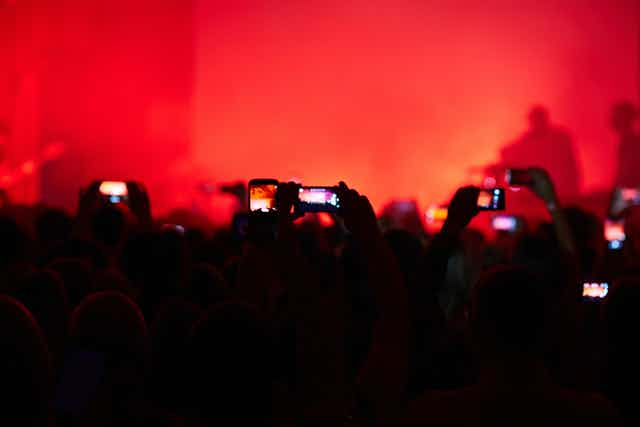Fans of singer-songwriter Alicia Keys were greeted with a simple message earlier this year when they entered the Highline Ballroom, in New York, to watch her perform.
This is a phone free event.
Their smartphones were placed in a lockable pouch distributed by the consumer electronics company, Yondr. They carried the pouch with them, only opening it when they exited the venue by tapping on a metal disc located at the main door.
No mobile video or audio recording, live streaming, tweeting, status updates, texting or phone calls occurred while Keys performed on stage.

This arrangement met with a range of responses including open frustration, muted acceptance and enthusiastic embrace.
Yondr’s website presents an intriguing promise about the experience of phone-free space. Recalling an era before smartphones and broadband mobile services, the company promises to show people “how powerful a moment can be” once the habitual checking and constant use of smartphones is stopped.
Rather than offering connection, it says smartphones cut “people off from each other”, distracting the attention of the user and diminishing the emotional purchase of live events.
Others seek to ban the smartphone
Other artists including The Lumineers, Guns N Roses, Louis CK and Dave Chappelle, have backed Yondr’s promise by employing the pouch at their shows.
Other performers have objected openly to mobile media use by audience members. Performing in Verona, Italy, British performer Adele rebuked a woman for filming her as she sang, arguing:
Because I’m really here in real life, you can enjoy it in real life rather than through your camera.
In 2014, the renowned singer-songwriter Kate Bush asked fans to leave their smartphones and tablets at home during her comeback gigs in London. She wrote on her website:
I very much want to have contact with you as an audience, not with iPhones, iPads or cameras.
Parallel appeals are evident in live sport. Celebrity entrepreneur and team owner of the NBA’s Dallas Mavericks, Mark Cuban has advocated against the use of smartphones at live basketball games since 2010.
Much like his appearances on Shark Tank, Cuban’s message is delivered with characteristic bluntness:
We don’t need no stinking smartphones!
Cuban warns spectators that looking down at a mobile screen during play could mean missing:
[…] the look on the face of your child, or your date, and the everlasting memories that are created from games.
Cuban’s argument corresponds with a group of ardent fans who follow the Dutch football team, PSV Eindhoven.
The opening home game of the 2014-15 season witnessed a protest by fans against the installation of a new Wi-Fi network in the stadium. A large banner held aloft during the game made it very clear what fans thought of Wi-Fi.
The protest met with approval by a vocal subsection of fans who post in online football forums.
The live experience
The conflicted relationship between mobile use and non-use is a common dominator in these events. The power of live performances and games is built on the heightened emotions and sensory engagement generated by the collective focus of a crowd.
But some performers and audience members believe that the constant use of smartphones and tablets by other attendees erodes the quality of their focus and experience. It is a situation in which each individual’s choice possesses exponential significance, producing the overall atmosphere of a live event.
The widespread coverage given to the likes of Keys, Bush, Cuban and others says a great deal about the contested status of mobile technology use in social life.
The problem is a failure to reflect on the impact of smartphone and tablet use in particular social situations. It is necessary to think about and discuss the ways mobile media connect and disconnect people to differing degrees and in different ways.
A failure to do so risks the thoughtless prioritisation of always-on mobile connectivity to the detriment of potentially memorable social experiences. A temporary disengagement from mobile media is sometimes the preferable arrangement.
The shared event
The question of how to best integrate technical and social forms of connectivity requires an understanding of what is shared at events such as concerts and sporting fixtures.
With regard to smartphones, sharing encompasses images, footage, audio content, messages and related information (the songs played and live sport scores). The circulation of these items manifests the experiences and reactions of users, as well as a feeling of camaraderie with friends and networks.
But sitting alongside these media practices are the collective excitement, togetherness and emotions generated by crowds as they focus on a spectacle together, and the lasting memories these experiences create.
The balance between these forms of sharing in a mobile age is unpredictable and occasionally cause for visible disagreement.
We are all a part of the unfolding response to this conundrum, which demands social experience be taken as seriously as economic considerations in figuring the role of mobile devices in our lives. This is not always an easy task when faced by the seductive marketing efforts of digital technology giants such as Apple, Samsung, Google, Facebook and Twitter.
But mobile media users must contemplate how incessant sharing serves the commercial interests of social networking platforms, digital data harvesters, mobile advertisers and telecommunications carriers.
Conscientious non-users also need to pause and ask how their stance is leveraged by those seeking to protect intellectual property and minimise the circulation of content on platforms such as YouTube and Facebook.
Even as it sells tens of millions of iPhones each quarter, Apple has hinted at a move in this direction by registering a patent that would prohibit phone cameras from recording footage in designated areas.
The outstanding question is how much content people really need to record, produce and distribute via their smartphone before they miss witnessing or sharing something significant in their immediate environment.

